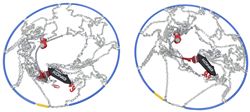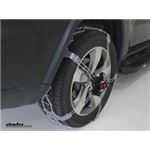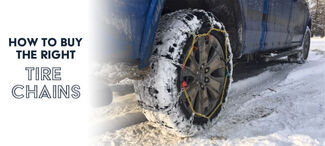
Tire Chains for 2019 Chevy Traverse with 255/55R20 Tires
Question:
We have a 2019 AWD Chevy Traverse 255/55 R20. The owners manual states not to use snow chains. Does this mean you cant use snow cables either? If so what do people use to go to Big Bear when they require chains? Our rims are black so we dont want to mess up them up. What would you suggest?
asked by: Sherri S
Expert Reply:
The owner's manual for the 2019 Chevy Traverse does say on page 344 that tire chains should not be installed on any tire size other than size P255/65R18. This restriction is due to limited wheel well clearance when the vehicle is fitted with larger tires. It also states to use traction devices only on the front tires.
Some regions have tire chains laws that legally require you use them (or at least to have them in the vehicle) under certain weather conditions and/or in certain specific driving areas. Since the car maker cannot force you to break the law the use of certain chains is permissible, such as the Konig Premium Self-Tensioning Snow Tire Chains # TH02230K77 which do fit your tire size P255/55R20.
These chains are special in that they do not require any clearance on their inward facing side. These clamp onto the wheels and cover only the tread surface, without wrapping around the back side of the tires where they could risk damage to components like brake lines. This clamp-on design gives them a zero clearance requirement and helps protect your rims from scratches since no part of the chain will contact the rim.
Please check out the linked photo that shows this chain installed; you can see that the rims make no direct contact with the chains. The included video will also help you see how these chains install.
Always drive slowly with chains installed, not more than 30-mph; also always remove the chains as soon as you reach clear pavement.

Products Referenced in This Question
Konig K-Summit Tire Chains - Diamond Pattern - Square Link - Assisted Tensioning - 1 Pair
- Tire Chains
- Tire Chains
- Steel D-Link w Ice Spikes
- Rim Protection
- Deep Snow
- Ice
- On Road Only
- Automatic
- Class S Compatible
- Clamp Onto Tire
- Konig
more information >
Product Page this Question was Asked From
Konig Tire Chains - Diamond Pattern - Square Link - Self Tensioning - 1 Pair
- Tire Chains
- Tire Chains
- Steel Square Link
- Rim Protection
- Deep Snow
- On Road Only
- Automatic
- Class S Compatible
- Drape Over Tire - Make Connections
- Konig
more information >
Featured Help Information
Instructions
Miscellaneous Media

Continue Researching
- Shop: Tire Chains
- Video: Best 2021 Chevrolet Traverse Tire Chain Options
- Shop: Glacier Tire Chains w/ Cam Tighteners - Ladder Pattern - Twist Links - Assisted Tensioning - 1 Pair
- Q&A: Can Tire Chains Be Used On a 2019 Chevy Traverse with 255/55-20 Tires
- Shop: Konig K-Summit Tire Chains - Diamond Pattern - Square Link - Assisted Tensioning - 1 Pair
- Video: Titan Chain V-Bar Snow Tire Chains Installation - 2016 Toyota Tacoma
- Video: Titan Chain Snow Tire Chains Installation - 2016 Toyota Tacoma
- Article: Snow Tire Chain Overview: How to Buy the Right Tire Chains
- Search Results: xg 12 pro 247
- Shop: pewag Wide Base Tire Chains w Cams - Ladder Pattern - Grooved Square Link - Assisted Tension - 1 Set
- Shop: Titan Chain Cable Tire Chain - Diagonal Pattern - Roller Links - Manual Tensioning - 1 Pair
- Shop: Titan Chain Snow Tire Chains w Cams - Ladder Pattern - V Bar Links - Assisted Tensioning - 1 Pair
- Shop: Konig K-Summit Tire Chains - Diamond Pattern - Square Link - Self Tensioning - 1 Pair
- Shop: Titan Chain Snow Tire Chains - Ladder Pattern - V Bar Links - Manual Tensioning - 1 Pair
- Q&A: Should Ladder Chains or Diamond Pattern Chains be Installed on Rear Tires of a 2006 Ford F-250
- Q&A: Can Class U Tire Chains be Used on a Vehicle that Calls for Class S Chains
- Video: Konig Standard Snow Tire Chains Review TH01571265
- Q&A: Tire Chain Recommendations for 2014 Toyota Tacoma With 265/65R17 Tires
- Q&A: How Thick Are Chain Links of Glacier V-Bar Snow Tire Chains
- Article: Brake Controller 7- and 4-Way Installation Kit (ETBC7)
- Shop: Trailer Hitch
- Q&A: What is the Difference Between a Class II and a Class III Hitch?
- Search Results: tire chains
- Video: Titan Chain Diamond Alloy Snow Tire Chains Review TC1505
- Article: Trailer Wiring Diagrams
- Video: Konig Self-Tensioning Snow Tire Chains Review
- Search Results: snow chains
- Q&A: Are Ladder or Diamond Style Chains Better for Deep Snow
- Shop: Trailer Wiring
- Video: Titan Chain Snow Tire Chains with Cams Review TC2809CAM
































